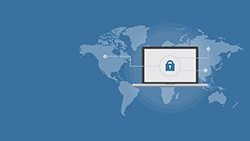 The federal Internet Crime Complaint Center received more than 330,000 complaints in 2009, and more than a third of them ended up in the hands of law enforcement. The damages from those referred to the authorities totaled more than a half billion dollars. The Government Accountability Office estimated that cyber crime cost U.S. organizations $67.2 billion in 2005; that number has likely increased since then. With so much of business today done electronically, organizations of all types are highly vulnerable to theft and corruption of their data. It is important for them to identify their loss exposures, possible loss scenarios, and prepare for them. Some of the questions they should ask include:
The federal Internet Crime Complaint Center received more than 330,000 complaints in 2009, and more than a third of them ended up in the hands of law enforcement. The damages from those referred to the authorities totaled more than a half billion dollars. The Government Accountability Office estimated that cyber crime cost U.S. organizations $67.2 billion in 2005; that number has likely increased since then. With so much of business today done electronically, organizations of all types are highly vulnerable to theft and corruption of their data. It is important for them to identify their loss exposures, possible loss scenarios, and prepare for them. Some of the questions they should ask include:
What types of property are vulnerable?
The organization should consider property it owns, leases, or property of others it has in its custody. Some examples:
-
- Money, both the organization’s own funds and those it holds as a fiduciary for someone else
-
- Customer or member lists containing personally identifiable information, account numbers, cell phone numbers, and other non-public information
-
- Personnel records
-
- Medical insurance records
-
- Bank account information
-
- Confidential memos and spreadsheets
-
- Software stored on web servers
Different types of property will be susceptible to various threats, such as embezzlement, extortion, viruses, and theft.
What loss scenarios could occur?
The organization needs to prepare for events such as:
-
- A fire destroys large portions of the computer network, including the servers. Operations cease until the servers can be replaced and reloaded with data.
-
- A computer virus infects a workstation. The user of that computer unknowingly spreads it to everyone in his workgroup, crippling the department during one of the year’s peak periods.
-
- The accounting department discovers a pattern of irregular small funds transfers to an account no one has ever heard of. The transfers, which have been occurring for almost three months, were small enough to avoid attracting attention. They total more than $10,000.
-
- A vendor’s employee strikes up a casual conversation at a worker’s cubicle and stays long enough to memorize the worker’s computer password, written on a post-it note stuck to her monitor. Two weeks later, technology staff discovers that an offsite computer has accessed the human resources database and viewed Social Security numbers, driver’s license numbers, and other personal information.
In addition to taking steps to prevent these things from happening, the organization should consider buying a Cyber insurance policy. Several insurance companies now offer this coverage; although no standard policy exists yet, the policies share some common features. They usually cover property or data damage or destruction, data protection and recovery, loss of income when a business must suspend operations due to data loss, extra expenses necessary to maintain operations following a data event, data theft, and extortion.
However, each company might define these coverages differently, so reviewing the terms and conditions of a particular policy is crucial. Choosing an appropriate amount of insurance is difficult because there is no easy way to measure the exposure in advance.
Consultation with the organization’s technology department, insurance agent and insurance company might be helpful. Finally, all policies will carry a deductible; the organization should select a deductible level that it can afford to pay and that will provide it with a meaningful discount on the premium. Once management has a thorough understanding of the coverages various policies provide in relation to the organization’s exposures, it can fairly compare the costs of the policies and make an informed choice.
Computer networks are a necessary part of any organization’s environment today. Loss prevention and reduction techniques, coupled with sound insurance protection at a reasonable cost, will enable an organization to get through a cyber loss event.

 According to a phishing study conducted by KnowBe4, employees in the insurance, manufacturing and technology industries click
According to a phishing study conducted by KnowBe4, employees in the insurance, manufacturing and technology industries click  By 2019, the cybersecurity industry will face a deficit of over two million professionals. Whether your company needs a solid cybersecurity team or already has a great team in place, consider taking steps to fight this deficit and protect your business.
By 2019, the cybersecurity industry will face a deficit of over two million professionals. Whether your company needs a solid cybersecurity team or already has a great team in place, consider taking steps to fight this deficit and protect your business. Cyber breaches that affect big businesses make the news, but over 60 percent of all cyber breaches target small and medium-sized businesses. Because you must protect your business, no matter what its size, purchase adequate cyber liability insurance.
Cyber breaches that affect big businesses make the news, but over 60 percent of all cyber breaches target small and medium-sized businesses. Because you must protect your business, no matter what its size, purchase adequate cyber liability insurance. Your company’s website shares information about your business and promotes sales. Hackers can access your website and wreak havoc on your business, though, as they steal customer data, post negative messages to customers or destroy records. As you lock your company’s doors every day, implement several tips as you protect your website, your reputation and business.
Your company’s website shares information about your business and promotes sales. Hackers can access your website and wreak havoc on your business, though, as they steal customer data, post negative messages to customers or destroy records. As you lock your company’s doors every day, implement several tips as you protect your website, your reputation and business. Your customers entrust their personal data to you and your company. Your employees may easily share information, though, particularly if you operate an open office with little privacy. Protect your customers’ information and identities when you follow several tips.
Your customers entrust their personal data to you and your company. Your employees may easily share information, though, particularly if you operate an open office with little privacy. Protect your customers’ information and identities when you follow several tips. With a virtual payment terminal, you can take payments over the internet. Not only will you boost sales, but you’ll also offer convenience to your customers. Your virtual payment terminal may be vulnerable to security risks, though, so follow several tips as you reduce liability and protect your customers and business.
With a virtual payment terminal, you can take payments over the internet. Not only will you boost sales, but you’ll also offer convenience to your customers. Your virtual payment terminal may be vulnerable to security risks, though, so follow several tips as you reduce liability and protect your customers and business.

 Cyber attacks threaten more than your company’s computers. They could affect your company’s ability to stay in business. Prepare for a safe and secure 2018 when you boost cyber security.
Cyber attacks threaten more than your company’s computers. They could affect your company’s ability to stay in business. Prepare for a safe and secure 2018 when you boost cyber security.



